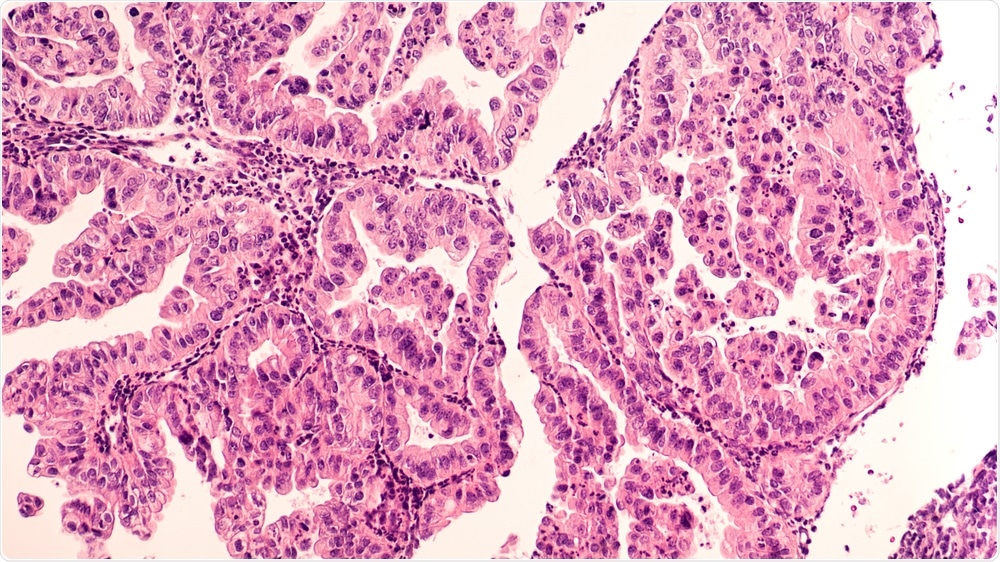A team at Shanghai Jiao Tong University, China, has revealed the existence of viable biomarkers of ovarian cancer by investigating the profiles of circular RNA expression in patients with ovarian cancer.

Image Credit: David. A. Litman/Shutterstock.com
Circular RNA profiles have previously been identified as being connected with various types of cancer, serving as biomarkers to enable the early detection of disease, and therefore improving the outcomes of treatment by allowing it to begin at earlier stages when the disease is more controllable.
However, studies into the differential circular RNA expression in ovarian cancer had been lacking until the Shanghai Jiao Tong University team published their study last month in the journal, Gene.
How circular RNAs can signal cancer
Back in 2012, it was discovered that circular RNA (circRNA) is the most dominant RNA isoform produced from eukaryotic genes. Previously it was believed that variants of messenger RNA had been most dominant.
Since this discovery, these single-stranded closed RNA molecules have been established as biomarkers of several diseases, most notably, of numerous forms of cancer.
They have high stability, prevalence, and have retained their unique properties and the functions across eukaryote species. They play vital roles as protein sponges and efficient microRNAs, as well as being vital to the modulation of transcription and splicing.
Pathological conditions can also be identified by uncovering the circRNAs expressed in the affected tissues. This application, in particular, has led to new methods of disease diagnosis and monitoring in cancer by using these loops of DNA as biomarkers, as well as helping to develop new therapeutic targets.
A call for better treatments for ovarian cancer
Ovarian cancer is one of the most common types of cancer in women, it is also one of the most prevalent gynecologic diseases across the world. Over 295,000 new cases were diagnosed in 2018, and around 184,000 were reported to have died from the disease during the same year.
The disease has a relatively high fatality rate, and this is considered to be because four out of five women who receive a diagnosis are already in the advanced stages of the disease.
While significant developments have been made in the areas of chemotherapy and surgical treatment, the survival rate for this type of cancer remains poor. It is clear that new methods are needed that can detect ovarian cancer at an early stage, when it is more treatable, giving women a better chance at survival.
The team at Shanghai Jiao Tong University recognized this need to develop systems that can earlier diagnose ovarian cancer, and they sought to conduct a study the profiles of circRNA, something that has previously been successful in highlighting biomarkers for other cancer types, but up until now had not been thoroughly investigated in ovarian cancer.
Linking circular RNA expression with the presence of cancer
Blood was collected from women with ovarian cancer as well as from healthy controls. The team ran second-generation sequencing on the samples to highlight circRNAs expressions that significantly differed between the two groups, and confirmed the expression of these circRNAs with qPCR. These circRNAs were of interest because they could potentially serve as markers of disease.
Next, the possible associated biological functions of the highlighted circRNAs were investigated with a bioinformatics-based approach, and GO, KEGG, and network analyses were conducted to further investigate the circRNA expression.
A total of 178 differentially expressed circRNAs were observed in the blood of the patient group. Five of these were then validated by qPCR, and further analysis revealed the relationship between these circRNAs and transcriptional misregulation in cancer, FC gamma R-mediated phagocytosis, VEGF signaling, chemokine signaling, TNF signaling, and ErbB signaling.
Earlier detection of ovarian cancer?
Profiles of circRNAs that are specifically related to the presence of ovarian cancer were revealed in this study.
There is a potential to use these profiles as biomarkers of ovarian cancer, which could potentially be used to develop new diagnostic methods that may detect cancer at earlier stages, to improve the survival rates of this kind of cancer.
Journal reference:
Wang, J., Wu, A., Yang, B., Zhu, X., Teng, Y. and Ai, Z. (2020). Profiling and bioinformatics analyses reveal differential circular RNA expression in ovarian cancer. Gene, 724, p.144150.